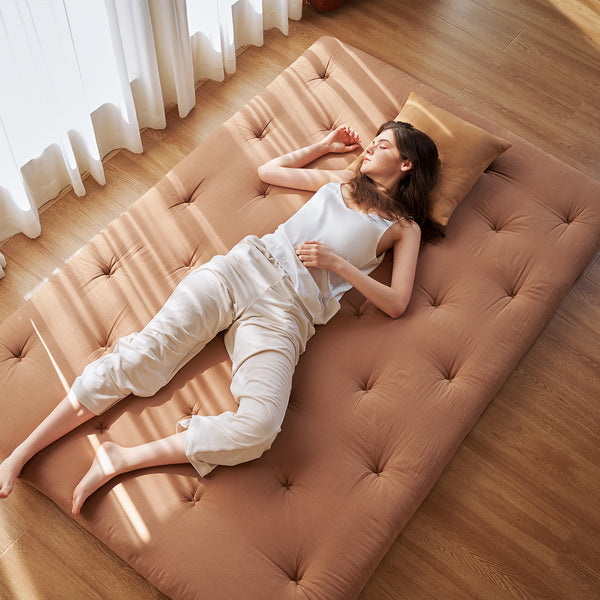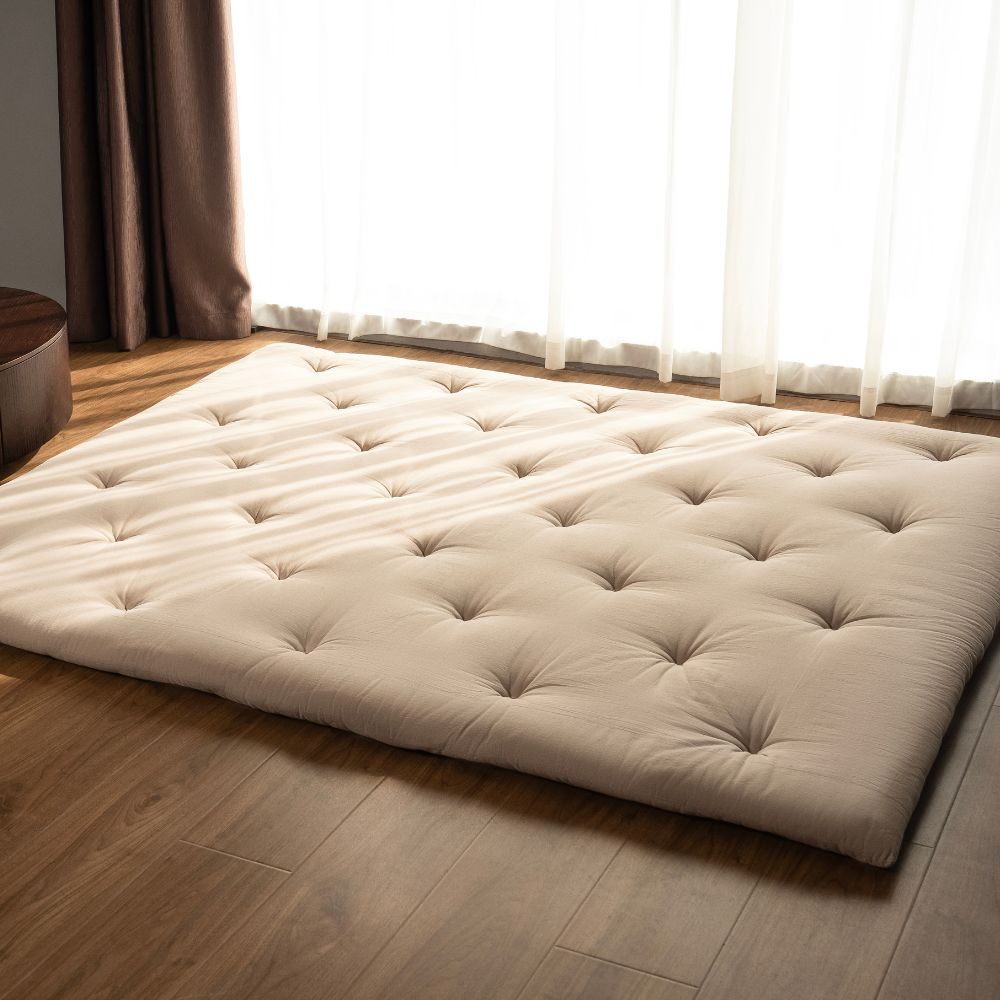Sleeping on the floor may seem unconventional to many, often dismissed as a cliché promoted by minimalist influencers. However, it offers a chance to embrace a simpler lifestyle, appreciated by many. While some may mock it as a sign of financial struggle, sleeping on a futon can actually be a deliberate and reasonable choice. This article explores the benefits of this lifestyle and helps you decide if it's right for you.
The common problem of the most bed
In many Western countries, the typical sleeping arrangement involves a plush bed with layers of pillows and blankets. However, this level of comfort can actually be a drawback. Imagine it like indulging in fast food every day - initially enjoyable, but ultimately unhealthy. Many people who are accustomed to this type of bed find themselves lounging for hours, feeling lethargic.
However, for those who have transitioned to sleeping on the floor, there's been a significant change. They no longer linger in bed unnecessarily; their futon provides just the right amount of support without being overly cushy. This balanced comfort encourages them to start their day promptly rather than getting lost in a cocoon of softness. It's a simple change that has made a big difference.
Benefits of sleeping on the floor
Relief from Back Pain:
Sleeping on the floor can help alleviate back pain by providing a firmer and more supportive surface that allows the spine to maintain its natural alignment throughout the night. Unlike soft mattresses that may cause improper spinal alignment, a firm floor surface can promote better posture and reduce pressure on the back.
Improved Posture:
With a firmer surface to sleep on, sleeping on the floor encourages better spinal alignment and posture, which can help prevent long-term issues related to poor posture. By providing support to the entire body, sleeping on the floor can help maintain proper alignment of the spine, shoulders, and hips.
Cooler Sleep Environment:
Sleeping on the floor tends to result in a cooler sleep environment compared to traditional mattresses. Since there is less insulation between the body and the floor, heat can dissipate more effectively, leading to a cooler and more comfortable sleep experience, especially during warmer seasons.
Control Over Resting Position:
Sleeping on the floor allows for greater control over resting positions, as there are no raised edges or barriers like those found on traditional mattresses. This can be particularly beneficial for individuals who prefer to sleep in various positions throughout the night, as they can easily adjust their sleeping posture without any hindrance.
Breaking the Habit of Lounging in Bed:
Traditional beds can often encourage lounging and spending excessive time in bed, leading to a sedentary lifestyle and feelings of lethargy. Sleeping on the floor eliminates the temptation to linger in bed unnecessarily, encouraging individuals to wake up and start their day promptly.
More Space:
Sleeping on the floor provides more floor space in the bedroom, as there is no bulky bed frame or mattress taking up valuable room. This can be advantageous for individuals living in smaller spaces or for those who prefer a minimalist aesthetic in their bedroom environment.
Enhanced Mental Clarity:
Sleeping on the floor can promote a sense of openness and mental clarity. Without the confines of a traditional bed frame and mattress, individuals may feel a greater connection to their surroundings and experience a sense of freedom. This can lead to more open thoughts and a clearer mind, allowing for improved focus and concentration during waking hours.
Considerations When Sleeping on the Floor
While the idea of sleeping on the floor may seem appealing, it isn’t for everyone. It's essential to weigh the potential drawbacks and find the healthy way to sleep on the floor.
Who should not sleep on the floor?
Individuals with severe back problems
Sleeping directly on the floor lacks the cushioning and support of a mattress, which can exacerbate back pain, especially for those with existing issues. Individuals with severe back problems should consult a doctor before making this change.
Individuals with limited mobility
If you struggle with sitting on the floor or getting back up, it's advisable to choose a bed for sleeping instead. Similarly, if you experience joint issues such as arthritis, floor-sleeping may exacerbate discomfort and should be avoided.
Cold Sleepers
While sleeping on the floor may suit hot sleepers, it may not be ideal for those who tend to get chilly. Floors can retain cold temperatures, especially in colder climates or poorly insulated spaces, leading to discomfort and difficulty staying warm during the night.
Allergy prone individuals
Sleeping on the floor exposes individuals to dust, dirt, and other allergens that accumulate on the ground. This heightened exposure can trigger allergic reactions like sneezing and congestion, affecting sleep quality and overall well-being.
Older adults
As we age, our bones weaken and fatty tissue decreases, making sleeping on the floor risky. It increases fracture risk and can cause excessive coldness.
People with limited mobility
Especially those who struggle to sit or rise from the floor, should avoid sleeping on the floor directly. This can be challenging and unsafe. Additionally, individuals with joint issues like arthritis may find it uncomfortable and exacerbate pain. Therefore, it's best for them to opt for a bed for safety and comfort.
How to sleep on the floor?

Support
Choose a clean and flat surface for sleeping to ensure proper support for your body. A hard surface can help maintain spinal alignment and alleviate pressure points. If the floor is too hard, you can use a floor mattress or a folded blanket for cushioning.
Position
Lie on your back or side with your body properly aligned. Sleeping on your back can help distribute weight evenly and reduce strain on your spine, while side sleeping can relieve pressure on your shoulders and hips.
Create a Clean Sleep Environment
Ensure the floor is clean and free of dust, dirt, and allergens. Use a mattress protector or clean bedding to create a barrier between your body and the floor, promoting hygiene and preventing contact with potential irritants.
Pay Attention to Bedding Selection
Choose bedding made from breathable materials like cotton or linen to help regulate body temperature and prevent overheating. Avoid bulky or heavy bedding that can restrict movement and cause discomfort.
Test and check if you like it
Experiment with different sleeping positions and bedding setups to find what works best for you. Pay attention to your comfort levels and make adjustments as needed to ensure a restful night's sleep on the floor. If it still doesn’t feel good to you, you can always switch back to a traditional bed.

